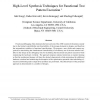DFT
2005
IEEE
14 years 2 months ago
2005
IEEE
A built-in self-test (BIST) scheme is presented which both reduces overhead for detecting random-pattern-resistant (r.p.r.) faults as well as reduces power consumption during test...
ICPP
1996
IEEE
14 years 4 months ago
1996
IEEE
- Among all software cache coherence strategaes, the ones that are based on the concept of tamestamps show the greatest potentaal an terms of cache performance. The early tamestamp...
ASPDAC
1998
ACM
14 years 4 months ago
1998
ACM
Functional debugging often dominates the time and cost of the ASIC system development, mainly due to the limited controllability and observability of the storage elements in desig...
DATE
2010
IEEE
14 years 5 months ago
2010
IEEE
Abstract—Built-In Self-Test (BIST) is less often applied to random logic than to embedded memories due to the following reasons: Firstly, for a satisfiable fault coverage it may...
VTS
2003
IEEE
14 years 5 months ago
2003
IEEE
Reseeding is used to improve fault coverage of pseudorandom testing. The seed corresponds to the initial state of the LFSR before filling the scan chain. The number of determinist...


